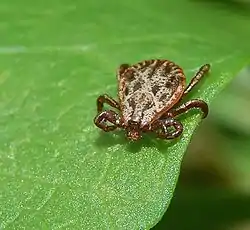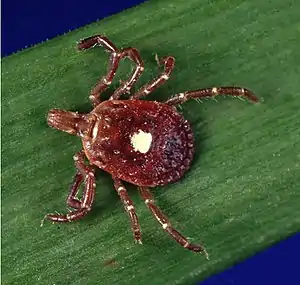Dermacentor reticulatus
Dermacentor reticulatus, also known as the ornate cow tick, ornate dog tick, meadow tick, and marsh tick,[2] is a species of tick from the family Ixodidae. It is the type species for the genus Dermacentor.[1] D. reticulatus is an ornate tick.[3] The female varies in size from 3.8–4.2 mm (unfed) to 10 mm when engorged after feeding.[4] The unfed male is 4.2–4.8 mm long.[4] D. reticulatus is found in Europe and Western Asia,[5] generally in wooded areas.[3]
| Dermacentor reticulatus | |
|---|---|
 | |
| Scientific classification | |
| Kingdom: | |
| Phylum: | |
| Class: | |
| Subclass: | |
| Order: | |
| Family: | |
| Genus: | |
| Species: | D. reticulatus |
| Binomial name | |
| Dermacentor reticulatus | |
| Synonyms | |
| |
Lifecycle
D. reticulartus has a three-host development cycle.[6] The adult female remains on a host for 9–15 days,[7] and can lay 3000–4500 eggs,[7] although the total number of eggs depends on the size of the female.[3] The larva hatches from the egg in 14–21 days.[8]
Disease transmission
D. reticulatus is a vector of various disease organisms, including Babesia canis, Francisella tularensis, Coxiella burnetti, Theileria equi, and several Rickettsia species,[9] such as Rickettsia slovaca.[10]
See also
References
- Guglielmone, AA; Robbins, RG; Apanaskevich, DA; Petney, TN; Estrada-Peña, A; Horak, IG; Shao, R; Barker, SC (6 July 2010). "The Argasidae, Ixodidae and Nuttalliellidae (Acari: Ixodida) of the world: a list of valid species names" (PDF). Zootaxa. 2528: 1–28. doi:10.11646/zootaxa.2528.1.1. ISSN 1175-5326.
- Földvári, G; Široký, P; Szekeres, S; Majoros, G; Sprong, H (1 June 2016). "Dermacentor reticulatus: a vector on the rise". Parasites & Vectors. 9 (1): 314. doi:10.1186/s13071-016-1599-x. PMC 4888597. PMID 27251148.
- Wall, RL; Shearer, D (2008). "Dermacentor reticulatus". Veterinary ectoparasites: biology, pathology & control (2nd ed.). Chichester: John Wiley & Sons. p. 73. ISBN 9780470680223.
- Taylor, MA; Coop, RL; Wall, RL, eds. (2015). "Dermacentor reticulatus (ornate dog tick, marsh tick, meadow tick)". Veterinary parasitology (4 ed.). John Wiley & Sons. p. 247. ISBN 9781119073697.
- Karbowiak, G; Biernat, B; Szewczyk, T; Sytykiewicz, H (2015). "The role of particular tick developmental stages in the circulation of tick-borne pathogens affecting humans in Central Europe. 1. The general pattern". Annals of Parasitology. 61 (4): 221–8. doi:10.17420/ap6104.11. PMID 26878618.

- Nowak-Chmura, M; Siuda, K (2012). "Ticks of Poland. Review of contemporary issues and latest research". Annals of Parasitology. 58 (3): 125–55. PMID 23444797.

- Arthur, DR (1960). "Dermacentor reticulatus Fabricius 1794". Ticks a monograph of the Ixodoidea: Part V: On the genera Dermacentor, Anocentor, Cosmiomma, Boophilus & Margaropus. Cambridge University Press. pp. 106–114.
- Mehlhorn, H, ed. (2008). "Dermacentor reticulatus". Encyclopedia of parasitology (3rd ed.). Berlin: Springer. pp. 324–325. ISBN 9783540489948.
- Lüssenhop, J; Bäumer, W; Kietzmann, M; Schnieder, T; Wolken, S (30 March 2011). "Dynamics of distribution and efficacy of different spot-on permethrin formulations in dogs artificially infested with Dermacentor reticulatus". Parasites & Vectors. 4: 45. doi:10.1186/1756-3305-4-45. PMC 3073924. PMID 21447196.
- Karbowiak, G; Biernat, B; Stańczak, J; Szewczyk, T; Werszko, J (2016). "The role of particular tick developmental stages in the circulation of tick-borne pathogens affecting humans in Central Europe. 3. Rickettsiae". Annals of Parasitology. 62 (2): 89–100. doi:10.17420/ap6202.38. PMID 27614472.

